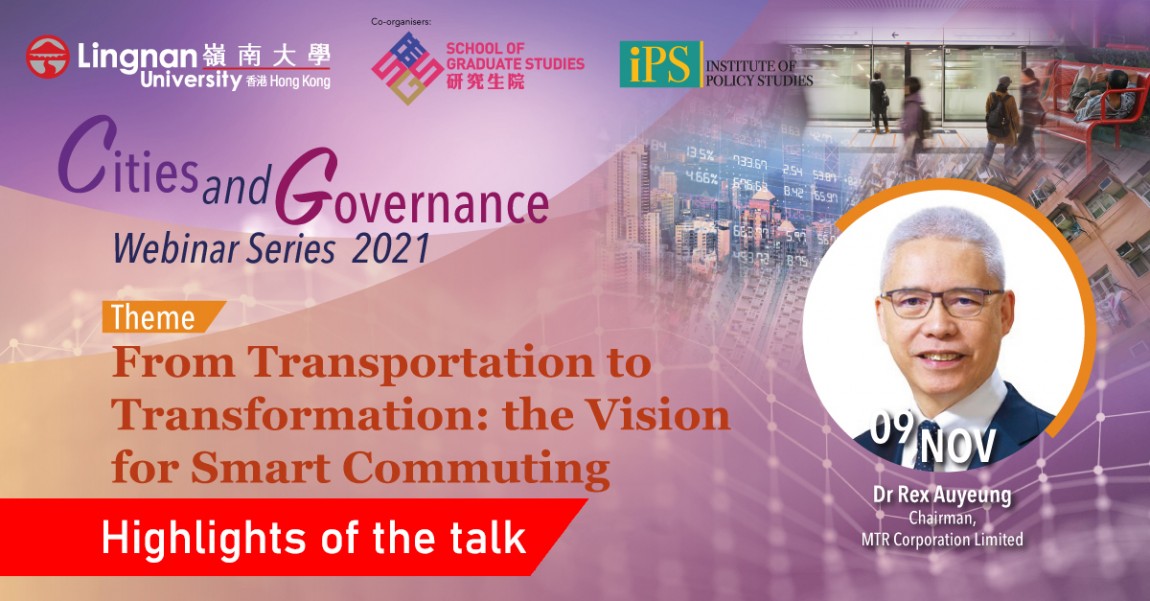Getting on track for a smarter city

Now that over 50 percent of the world’s population lives in cities, implementing a smart mobility strategy is becoming increasingly important for sustainable urban development. In his contribution to Lingnan University’s 2021 Cities and Governance Webinar Series, Dr Rex Auyeung, the Non-executive Chairman of the Board of Directors of the MTR Corporation, set out his business’s vision for smart commuting.
“Infrastructure and transport networks are under immense pressure to meet the demand,” Dr Auyeung told his audience. “That is why we need smart mobility to improve accessibility, and support economic and community development.”
The MTR’s unique rail-plus-property model
Over the 42 years of its existence, the MTR Corporation has grown from a local railway operator to a corporation that now not only runs a 266km railway network, connecting 98 stations, and with additional light rail infrastructure, but is also involved in a wide range of other business activities. These activities include property development and management, advertising, telecommunication services, and international consultancy.
This evolution has been founded on the corporation’s unique rail-plus-property business model, Dr Auyeung explained. While many railway systems around the world rely on continuous government funding, the MTR is self-financing. This remains true even during the height of the COVID-19 pandemic in Hong Kong.
In this model, the MTR Corporation obtains land development rights from the government and then not only builds railway infrastructure like stations and track, but also works with property developers to build residential and commercial developments. This not only generates profits, but also creates accessible communities to help meet Hong Kong’s housing and economic needs, and by reducing car use, lowers carbon emissions and pollution.
Major property development projects have been completed at 40 MTR stations, providing over 110,000 housing units. Fourteen shopping malls are also under the corporation’s management.
Along the Tung Chung Line, which connects Central to Hong Kong International Airport, a number of new neighbourhoods have been created. Perhaps the most eye-catching example is at Kowloon Station, where the development consists of a vast number of homes, a huge amount of office space, a prestigious mall, and open space that extends to the Kowloon waterfront.
While LOHAS Park may now be Hong Kong’s largest residential estate, 18 years ago there were just a collection of small villages and an MTR depot on the site. The construction of a passenger rail link and station made the area accessible, and enabled a community of 68,000 people, with essential retail, leisure and entertainment facilities, to be created.
Dr Auyeung said the level of profits generated by the MTR is sometimes questioned. “But our return on investment (ROI) is only about 7 percent,” he noted, adding a 10 percent return on investment is more common for listed companies, both in Hong Kong and around world.
After pointing out that MTR fares are at the lower end of those charged by the world’s metro systems, he went on to list the corporation’s various forms of ‘profit sharing with the public’. In 2019, this ‘sharing’ totalled HK$12.7 billion, consisting of dividends and tax paid to the government, a merger payment to the Kowloon-Canton Railway Corporation, and fare concessions to students, the elderly, and the disabled.
The current model is needed, he said, as running a rail system is capital intensive. Maintenance alone costs HK$10 billion a year, and it is estimated that the five new lines, and the additional 50-100km of track planned, will cost HK$200 billion over the coming years.
The Smart future for Hong Kong and the world’s cities
Developments in Rail Tech and Smart City technologies have opened up new opportunities, Dr Auyeung pointed out. That is why the corporation began a process that engaged consultants, board members, and the executive management team to devise a strategy for improving customer experience, exploring new growth opportunities, as well as planning for steady growth, both on the Mainland and internationally.
Launched in 2021 the new strategy has seven goals. These are to: accelerate digitalisation and leverage existing expertise; provide customer-centric services; embed inclusion and diversity throughout the business; expand the focus on ESG; support sustainable urbanisation; transform the governance model to support new growth areas; and, improve the corporation’s resilience in order to ‘Keep Cities Moving’.
These goals can, in turn, be boiled down to three foundational pillars: to attain the full potential of the core business in Hong Kong; expand into new hubs and new products, both on the Mainland and internationally; and, invest in new technologies and mobility services for long-term growth.
In Hong Kong, the aims of the new strategy are to further implement the concepts of Smart Mobility, Smart Maintenance, and Smart Community. The development of mobile apps, and the even greater integration of tech into station design, is intended to enhance the MTR customer experience. While the application of big data and other technologies, will improve maintenance and other efficiencies. Finally, a Smart City prototype for developing seamless connectivity between railway stations and the community around them is already being developed, Dr Auyeung said. “We are turning the Siu Ho Wan depot into a community in which we are building 22,000 residential units of which half are subsidised housing.”

